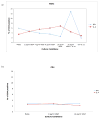Evidence of systemic Th2-driven chronic inflammation in patients with metastatic melanoma
- PMID: 19240164
- PMCID: PMC2757059
- DOI: 10.1158/1078-0432.CCR-08-1980
Evidence of systemic Th2-driven chronic inflammation in patients with metastatic melanoma
Abstract
Purpose: Immunotherapeutic modalities are commonly used for treatment of patients with melanoma. The therapeutic success in preclinical models has not yielded the expected clinical results. To understand this discrepancy, we attempted to define immune homeostasis of 209 patients with melanoma across stages of disease relative to normal controls.
Experimental design: Peripheral blood mononuclear cells (PBMC) and plasma were collected from patients and healthy donors. PBMC were analyzed for frequencies of natural killer, dendritic, and T cells and their functional status. Matched plasma samples were analyzed for the concentrations of 27 cytokines, chemokines, and growth factors. RNA was isolated from 24 metastatic melanoma tumor biopsies and profiled by microarray analysis.
Results: The frequency of natural killer, T, and dendritic cells in patients does not significantly change across stages of melanoma. However, plasma concentrations of Th2 cytokines [interleukin (IL)-4, IL-5, IL-10, and IL-13] in tumor-bearing patients were significantly higher than those with resected melanoma. Expression array analysis of metastatic melanoma revealed that the malignant melanocytes were not the source of the Th2 cytokines but did highly up-regulate vascular endothelial growth factor (VEGF) transcripts, consistent with plasma VEGF concentrations. In vitro VEGF exposure of normal PBMC lead to repolarization from Th1 to Th2 emulating the state of metastatic melanoma.
Conclusions: Patients with metastatic melanoma exist in a state of Th2-mediated "chronic inflammation" as a result of at least VEGF overproduction by malignant tumors. These data support prior observations regarding the effect of VEGF on immune cell function and suggests consideration of VEGF inhibitors in future cancer immunotherapy clinical studies in metastatic melanoma.
Figures




Similar articles
-
Dendritic cell immunotherapy combined with cytokine-induced killer cells promotes skewing toward Th2 cytokine profile in patients with metastatic non-small cell lung cancer.Int Immunopharmacol. 2015 Apr;25(2):450-6. doi: 10.1016/j.intimp.2015.02.010. Epub 2015 Feb 16. Int Immunopharmacol. 2015. PMID: 25698555 Clinical Trial.
-
Malignant melanoma associates with Th1/Th2 imbalance that coincides with disease progression and immunotherapy response.Neoplasma. 2002;49(3):159-66. Neoplasma. 2002. PMID: 12098001
-
Metastatic lesions with and without interleukin-18-dependent genes in advanced-stage melanoma patients.Am J Pathol. 2013 Jul;183(1):69-82. doi: 10.1016/j.ajpath.2013.03.026. Epub 2013 May 23. Am J Pathol. 2013. PMID: 23707237
-
Disease-associated bias in T helper type 1 (Th1)/Th2 CD4(+) T cell responses against MAGE-6 in HLA-DRB10401(+) patients with renal cell carcinoma or melanoma.J Exp Med. 2002 Sep 2;196(5):619-28. doi: 10.1084/jem.20012142. J Exp Med. 2002. PMID: 12208877 Free PMC article.
-
Molecular immunological approaches to biotherapy of human cancers--a review, hypothesis and implications.Anticancer Res. 2006 Mar-Apr;26(2A):1113-34. Anticancer Res. 2006. PMID: 16619514 Review.
Cited by
-
Th17 cell function in cancers: immunosuppressive agents or anti-tumor allies?Cancer Cell Int. 2024 Oct 27;24(1):355. doi: 10.1186/s12935-024-03525-9. Cancer Cell Int. 2024. PMID: 39465401 Free PMC article. Review.
-
Decreased Interferon γ Production in CD3+ and CD3- CD56+ Lymphocyte Subsets in Metastatic Regional Lymph Nodes of Melanoma Patients.Pathol Oncol Res. 2015 Sep;21(4):1109-14. doi: 10.1007/s12253-015-9938-3. Epub 2015 May 3. Pathol Oncol Res. 2015. PMID: 25933640
-
The systemic cytokine environment is permanently altered in multiple myeloma.PLoS One. 2013;8(3):e58504. doi: 10.1371/journal.pone.0058504. Epub 2013 Mar 27. PLoS One. 2013. PMID: 23544044 Free PMC article.
-
Serum levels of vascular endothelial growth factor are increased and correlate with malnutrition, immunosuppression involving MDSCs and systemic inflammation in patients with cancer of the digestive system.Oncol Lett. 2013 May;5(5):1682-1686. doi: 10.3892/ol.2013.1231. Epub 2013 Mar 6. Oncol Lett. 2013. PMID: 23761834 Free PMC article.
-
The Inflammatory Status of Soluble Microenvironment Influences the Capacity of Melanoma Cells to Control T-Cell Responses.Front Oncol. 2022 Mar 28;12:858425. doi: 10.3389/fonc.2022.858425. eCollection 2022. Front Oncol. 2022. PMID: 35419291 Free PMC article.
References
-
- Riker AI, Jove R, Daud AI. Immunotherapy as part of a multidisciplinary approach to melanoma treatment. Front Biosci. 2006;11:1–14. - PubMed
-
- Rosenberg SA, Sherry RM, Morton KE, et al. Tumor progression can occur despite the induction of very high levels of self/tumor antigen-specific CD8+ T cells in patients with melanoma. J Immunol. 2005;175:6169–76. - PubMed
-
- Vaishampayan U, Abrams J, Darrah D, Jones V, Mitchell MS. Active immunotherapy of metastatic melanoma with allogeneic melanoma lysates and interferon alpha. Clin Cancer Res. 2002;8:3696–701. - PubMed
-
- Osanto S, Schiphorst PP, Weijl NI, et al. Vaccination of melanoma patients with an allogeneic, genetically modified interleukin 2-producing melanoma cell line. Hum Gene Ther. 2000;11:739–50. - PubMed
Publication types
MeSH terms
Substances
Grants and funding
LinkOut - more resources
Full Text Sources
Other Literature Sources
Medical

